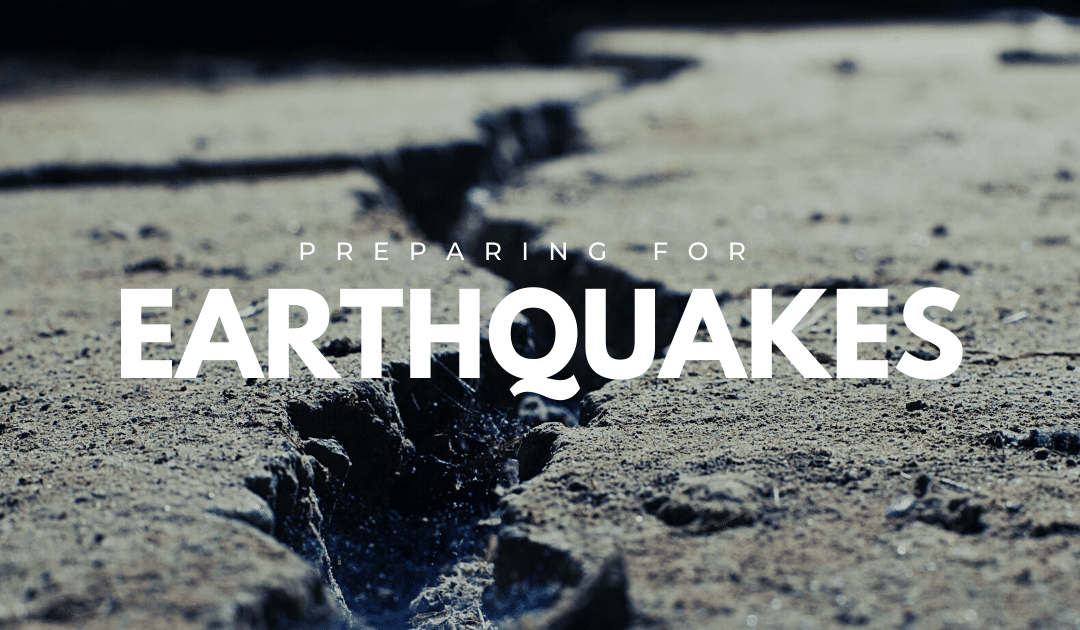
by California Casualty | Homeowners Insurance Info, Safety |
Chances are good that if an earthquake hits, you’ll be at home — especially now, when many of us are working at home due to coronavirus.
Luckily, there are simple things you can do today to safeguard your home and better protect yourself and your family before an earthquake strikes. Start with our 12 to-dos below. You’ll also find 3 top tips for what to do during a quake and, just as importantly, what not to do.
Inside Your Home
Whether it’s the kind that rolls in waves or arrives with a sudden jolt, an earthquake will surely shake your home and its contents. More people are injured by falling objects or furniture than by building damage. Make your home safer by securing and moving furniture and accessories, especially where people sit, sleep, or spend a lot of time. Pay special attention to heavy objects: move them lower to ground level and also make sure they’re not close to escape routes or doorways. Here are 12 other items to check and secure:
-
- Bookshelves – Tall bookshelves are an accident waiting to happen, as they’re unstable to begin with, and their contents can easily become airborne. Secure them to a wall stud using L-brackets and place the heaviest items on bottom shelves.
- Chemicals – If you have chemicals stored on open shelves in the garage or basement, protect them against spills by installing wood, plexiglass strips or wires to restrain them. If containers are behind cabinet doors, use latches to secure the doors.
- Display Cases – Secure these to the floor using appropriate brackets. Install safety glass if possible. Try to secure shelves inside the case as well.
- Electronics – For large electronics such as flat-screen TVs and entertainment centers, buy a “safety strap” kit, which contains straps and buckles designed for these heavy electronics.
- Hanging Objects – These are especially prone to be thrown around in a quake. Framed pictures and mirrors should be hung from closed hooks so they can’t bounce off walls. You can also use earthquake putty to secure corners. Move medium or large-sized pieces so they’re hung on studs, which is more secure being hung on drywall only. Make sure any hanging plants are well away from windows.
- HVAC Units – Anchor units using restraint brackets or seismic snubbers.
- Kitchen Cabinets – Shaking can cause cabinet doors to fly open and throw contents onto the floor. This can lead to a floor full of glass and ceramic shards – not to mention damage to countertops and walls. Secure cabinets by installing one or more of several latches: hook and eye, standard latch, pull/throwover, push latches, child-proof, or seismolatch.
- Piping – Secure all overhead pipes using brackets.
- Refrigerator – Secure refrigerators and other major appliances to wall studs using earthquake appliance straps.
- Space Heaters – These should be equipped with support legs and properly spaced angles. Learn online to DIY or hire a professional.
- Suspended AC Units – These should be braced with angles or welded to a support rod.
- Water Heater – Proper fastening involves having 2 straps that wrap completely around the unit and are screwed into studs of the wall.
What to Do During a Quake
The more you move or try to run during an earthquake, the greater chance you’ll be injured by falling or flying objects. Instead, remember to:
1. Drop to hands and knees – Do this before the earthquake knocks you down. It protects you from being thrown down and allows you to move if you need to.
2. Cover your head and neck – Get under a sturdy table or desk as soon as you can. If you can’t get to one, get next to low-lying furniture that won’t fall on you or next to an interior wall. Wherever you end up, cover your head and neck for protection.
3. Hold on to your shelter – Hold on to the table or desk (or your head and neck) until the shaking stops. If you’re under a table, be ready for it to shift as the quake rolls – and move with it.
What NOT to Do
1. Run outside – A building’s exterior walls are the most dangerous place to be during a quake. Facades, windows, and architectural details are often first to collapse or break. If you’re inside, don’t run outside, and if you’re outside, don’t run inside – crossing the building exterior puts you at risk of being injured by falling debris.
2. Stand in a doorway – It’s a long-held idea that a doorframe is the safest place to be. In modern homes, a doorframe is no safer than any other part of the house and won’t protect you from airborne or falling objects. You’re safer under a sturdy table.
3. Get in the “triangle of life” – An email that’s gone viral in the last few years offers advice counter to the long-established “Drop, Cover and Hold On” advice. The actions outlined have been discredited as potentially life-threatening by experts and their organizations.
Earthquake safety really boils down to preparation. Although you can’t control where you’ll be when one hits, you can prepare yourself and your home starting right now. Between the tips above – and our articles on what to do before and after a quake and emergency kit basics – you’ll be well on your way to pro-level preparation.
This article is furnished by California Casualty, providing auto and home insurance to educators, law enforcement officers, firefighters, and nurses. Get a quote at 1.866.704.8614 or www.calcas.com.

by California Casualty | Homeowners Insurance Info, Safety |
An earthquake, flood, fire, or severe storm can strike at any time — and you and your family may not be together when it does.
How will you find each other if separated? What about household members who have medical conditions? And what if your cell phones or networks are out of power?
Crafting an emergency plan before a disaster hits gives you time to discuss your family’s needs and circumstances, review possible scenarios, and decide on the best options together. Schedule a time when the whole family can participate. You may need one or two additional meetings to finalize all the details.
Here’s what you’ll need to cover:
1. Make A Plan of Action
Smart planning entails talking through a number of situations and “what-ifs.” Start by brainstorming around the following (and remember that coronavirus may affect some answers).
- What natural disasters are we most likely to experience?
- How will we receive emergency alerts and warnings?
- What are the escape or evacuation routes from our house?
- What is our shelter plan?
2. If Your Family is Separated
Re-opening across the country means parents may be going back to work and kids back to school. Are there other locations, such as after-school programs, childcare, gyms or volunteer sites that family members regularly attend? Consider those when answering the following:
- If separated during an emergency, where should we meet near our home?
- If meeting near home is impossible for some or all family members, what’s our meeting place?
- If we are separated, who is our emergency contact outside of our immediate area?
3. Specific Needs of Family Members
Remember to tailor your plan to address any particular needs of/by family members, such as:
- Medical needs including prescriptions and equipment
- Dietary needs
- Medical conditions, disabilities or functional needs, especially those requiring devices and equipment
- Language barriers or limitations
- Ages of all household members, including school-aged children
- Pets or service animals
- Religious and cultural considerations
5. Fill Out the Plan
After discussing the above, it’s time to get it all down on paper. Be sure to capture the following as well.
- All the contact information for each household member.
- Who’s responsible for what during the disaster? Tasks might include things like retrieving the disaster kit, evacuating pets, and fielding disaster updates and alerts.
- Create a personal network of friends, family or neighbors for things you might need help with.
- Make sure you have one or more out-of-town contacts for emergencies.
- Numbers for important contacts such as utilities, financial companies, childcare and caregivers, veterinarians, and insurance companies.
6. Share & Practice
During an emergency, cellular networks and wi-fi may be unreliable, and computers and phones may be lost or out of power. In these cases, having a paper copy of your family disaster plan can save precious time, minimize stress and prevent unnecessary emergencies. So, make sure each family member has a copy and carries it with them in a purse, backpack or work bag (here’s a template plan that fits in your wallet). Have regular family meetings to review the plan and practice. Finally, do a thorough review every 6 months or so, to update information or responsibilities.
7. Resources
Check out these resources to get your plan disaster-ready.
The perfect time to make a plan is right now. Getting all your family members on board and in the know sooner rather than later will ensure that you’re all ready when you need to be.
This article is furnished by California Casualty, providing auto and home insurance to educators, law enforcement officers, firefighters, and nurses. Get a quote at 1.866.704.8614 or www.calcas.com.

by California Casualty | Homeowners Insurance Info |
For homeowners looking to improve their abode, going the DIY route is tempting. It can save you money, allows for customization according to your needs and style, and can provide a sense of accomplishment and creativity.
That said, some renovation projects are best left to the experts. If you’ve got a project in mind, take a look at the following considerations to help you determine whether to hire out or do it yourself.
Questions To Consider:
What’s your skill level? In the age of YouTube, almost anyone can become a (near) master at anything. Depending on your project, you can find a ton of educational resources online to shore up the required skills and many times even the step-by-step instructions. Be honest in assessing your skills — if you feel comfortable and confident, great; if you feel out of your comfort or learning zone, look at hiring a professional.
Do you have stick-to-itiveness? All home reno projects are exciting in the “dreaming” and initial action phases, but do you have the patience to slog through the hard work and inevitable challenges? Multiple runs to the hardware store in a single day? Broken tools? Miscalculations of supplies or measurements? Maybe tackle a small project or two to test your longevity muscle.
How much time do you have? Try to gauge how much time your project will take (add a buffer of 20% or so), and realistically look at your available time. Evenings and weekends might be the quick answer, but remember you have a life and need downtime too. Also, think about the risk of a project dragging out unexpectedly. If your free time is tight or the family calendar too hectic, a professional contractor will save you sanity.
Is the project complex or dangerous? If your project involves asbestos, gas, electricity, or plumbing — or a mistake could cause serious consequences or harm — it’s best to go with a pro. Reputable contractors carry insurance and are current on all safety risks and requirements. They also have the expertise to advise you on any complicated aspects of the project, such as permitting, regulations, zoning, or structural issues.
Have you crunched the numbers? Usually, cost savings is a main factor for people going the DIY route. However, it’s smart to get a few estimates from professionals anyway and compare them to the DIY costs you’d rack up in materials, tools, and time. Don’t overlook opportunity cost — the time you could spend doing other important things in your life. And remember that for some materials, contractors can secure much better prices (or selection) than consumers.
Is good enough … good enough? Can you live with the end result not being absolutely perfect? Visible paintbrush lines? Tiles not quite even? A crooked cupboard? If so, DIY might be for you; if not, start asking around for professionals known for high-quality work.
Do you mind getting dirty? The majority of home remodeling is the demo work. It’s grueling, dusty, dirty, and messy. If you’re okay with that, more power to you on your DIY journey!
Here are some typical home renovation projects and whether they’re most suited to DIY homeowners or professionals. Many times, it boils down to question 4 above — the level of danger, expertise or complexity.
DIY:
-
- Update kitchen cabinet front panels
- Update interior door knobs or cabinet handles
- Fix or Install a toilet0
- Hang drywall
- Paint interiors
- Install laminate flooring
- Change a ceiling light
- Install baseboards
- Replace tile grout
- Replace tiles
Hire a Pro:
-
- Remodel bathroom
- Remodel kitchen
- Install hardwood or tile flooring
- Side the house
- Remove lead paint
- Make major structural repairs
- Replace windows
- Pave a driveway
- Repair or replace roofing
Sprucing up your home can improve its functionality, increase your property value, and boost your mood. Being thorough in comparing a DIY versus professional approach can help you come to the best decision for you and your family.
This article is furnished by California Casualty, providing auto and home insurance to educators, law enforcement officers, firefighters, and nurses. Get a quote at 1.866.704.8614 or www.calcas.com.
by California Casualty | Homeowners Insurance Info, Safety |
Warmer weather is on the horizon and you know what that means? it’s time to break out the gas and charcoal and grill up some juicy meals! But even grilling comes with its fair share of hazards. A small grill fire could easily lead to a home in flames. In fact, on average 10,200 house fires are started by grills each year, which estimates to be about a combined $37 million in property loss.
So, whether you are grilling for enjoyment, to host family and friends, or just for that savory flavor of summer, follow these simple grilling safety tips to help prevent a house fire:
1. Grill at least 10 feet from your home or garage
The farther away from any structures or home decor the better
2. Do not grill under any overhangs or structures
This includes branches, wires, carports, awnings, etc.
3. Do not leave your grill unattended
It only takes one minute for a fire to double in size
4. Turn on your grill and light your gas right away
Don’t wait, if the gas builds up it can cause an explosion
5. Make sure your grill is not leaking
Test it! Spray your tank with soapy water, if the water bubbles, you’ve got a leak
6. Keep your grill clean
Caked-on grease acts as fuel and will only make a fire stronger
7. Do not put too much food on at once
-Dripping fat will only make the flames stronger
8. Keep water or an extinguisher close by-
If a small fire were to start, you can catch and extinguish it at the source
9. Never grill indoors
A spark or flare-up could easily catch something on fire, plus grills release carbon monoxide, which can be deadly
10. Let your grill completely cool off before moving or covering it
Wait 2-3 hours after use and touch it with your hands, if it is still warm, then wait another 2-3 hours before moving or covering
While you’re enjoying your burger, all it takes is one ember on a cooling, unattended grill to bring your whole home down in flames. Have peace of mind knowing that should anything happen, your home will be protected by the proper homeowner’s insurance coverage.
This article is furnished by California Casualty, providing auto and home insurance to educators, law enforcement officers, firefighters, and nurses. Get a quote at 1.866.704.8614 or www.calcas.com.

by California Casualty | Homeowners Insurance Info, Safety |
According to the National Weather Service, drought conditions are expected to persist through the summer across many western states. If you’re a homeowner in a drought-prone area, that means monitoring water usage, thinking ahead to fire prevention and safety, and maintaining landscaping with drought tolerance in mind.
But there’s one more thing to think about: your foundation.
Drought threatens the integrity of your home’s structure in many ways and can end up costing tens of thousands in foundation repairs if problems are not caught early. Here are some of the most common signs of foundation stress or damage, and what you can do about it.
What’s Going On Under Your House?
When dry conditions persist, the soil under your home can lose enough moisture that it shifts and buckles, causing your foundation to crack. When rain finally returns, the soil soaks it up and expands, lifting up your foundation again, which can cause more cracking or unevenness. If your home, like most, has tree roots under it then the roots can draw moisture from the soil, adding to the problem.
Signs You Have a Problem…
A cracking foundation can cause a domino effect of problems up through the house. Here are some signs you might have issues.
-
- Cracks in rigid wall surfaces such as brick, concrete, stucco, tile, and drywall
- Windows and doors that begin sticking or become misaligned
- Leaks in the basement
- Broken pipes
- Gaps along cabinets, baseboards or outdoor trim
- Misalignment where your foundation meets an exterior wall
- Floors that sink or slope
- Cracked basement floor
- Cracked or shifted chimneys
- Cracked asphalt and pavement on driveways or walkways
What To Do About It
Do a careful inspection of your home inside and out. If you see cracks, take photos, measure, and record them so you have a history to compare with in the future. If the cracks are minor or few, just keep an eye on them. If you see anything serious or worrying, contact a professional. You want to prevent any foundational issues before they cause serious (and expensive) damage. Here are some preventive measures you can take to keep the ground under your home moist:
-
- Install a water system around your home.
- Add a few inches of mulch to your landscaping area.
- Plant drought-tolerant and fire-resistant shrubs and groundcover, which will hold moisture in the ground and keep it shaded, preventing evaporation.
- Keep up with weeding (weeds are thirsty).
- Plant any new trees far enough from the foundation to keep roots at a distance.
- As always in drought-prone areas, practice water conservation inside and outdoors.
Catching foundation problems before they get serious entails some extra time and attention on your part but will help you avoid costly repairs or even replacement of your foundation.
This article is furnished by California Casualty, providing auto and home insurance to educators, law enforcement officers, firefighters, and nurses. Get a quote at 1.866.704.8614 or www.calcas.com.

by California Casualty | Homeowners Insurance Info, Safety |
Did you know that many of the homes destroyed by wildfire actually caught fire from within the structure? This is because embers made their way inside the house through vents, windows, chimneys, or other openings.
Embers can travel more than a mile out ahead of the main fire body, igniting any dry fuel or easily ignited materials in their path. If they land on or become lodged in combustible materials on, in or near your house, they’ll gain a toehold and ignite.
To protect your home from an ember attack this fire season, check its exterior and perimeter for vulnerabilities, then fix, replace, adjust and clean as needed.
The First Line of Defense: Stop the Embers From Entering
Once an ember gets into your home it can burn out of control incredibly quickly. Block entry points by inspecting the following.
Vents – Install 1/8th inch metal mesh screening on attic, foundation, and eave vents to prevent embers from being sucked into your home.
Roofs – Replace wood shingles with non-combustible or fire-resistant roofing. Repair or replace any loose tiles and plug any openings.
Gutters – Remove dry fuels (dead leaves, pine needles, debris) from gutters and roof.
Siding and Trim – Caulk any gaps and replace materials as needed. Fire experts recommend having 5-6 inches of exposed concrete at the base of your house, rather than having siding reaching all the way to the ground where it’s vulnerable to embers. Finally, if you’re in a fire-prone area, consider fire-resistant siding or treatments.
Eaves – Eaves can be an entry point of fire getting into your attic. Cover them with sheathing and use fire-resistant materials where possible. Use tightly fitted joints (such as tongue and groove) instead of butt joints.
Chimneys and Stovepipes – Block out embers by installing a spark arrestor.
Skylights – The safest are double-paned glass, and one of the panes should be tempered glass. Replace any plastic skylights. If the fire is threatening, close skylights.
Windows – Replace non-tempered, single-pane windows with tempered, multi-paned glass. As with skylights, close all windows if a fire is possible.
Garage Door – Close doors as tightly as possible to prevent embers from entering. Consider using trim around the garage door opening to reduce gaps. Be sure the door is closed if there’s a chance of fire approaching.
The Second Line of Defense: Your 0-5 ft Perimeter
If an ember lands on dry, combustible fuel right at the edge of your home, it can spark a structure fire in seconds. Minimize those chances by looking at the following.
Decks and Porches – Repair or replace decayed materials and use metal flashing between the deck and house. Remove anything stored underneath the deck, as well as debris between deck boards or where it meets the house.
Patio Furniture – Move furniture and any other combustible items on your patio to the garage.
Flowerboxes – Remove if a wildfire is active in your area.
Wood Piles – Keep firewood stacks at least 30 feet from your house and other structures.
Propane Tanks – As with firewood, keep tanks no closer than 30 feet from structures.
Vehicles – Close all windows and back into the garage, or park well away from the house.
Mulch Around the Home – Mulch is flammable, so replace it with rock or gravel where it’s close to your home.
Branches and Shrubs – Make sure all are trimmed back. Replace flammable plants wherever possible.
Fortifying your home against embers is one important step in prepping for fire season. Download our checklist for fire readiness and creating a 100-foot defensible space around your home.
This article is furnished by California Casualty, providing auto and home insurance to educators, law enforcement officers, firefighters, and nurses. Get a quote at 1.866.704.8614 or www.calcas.com.





